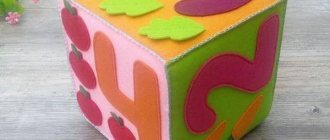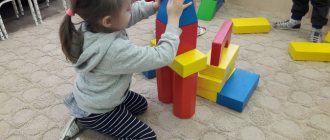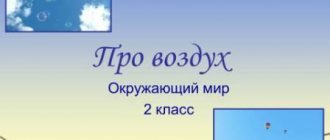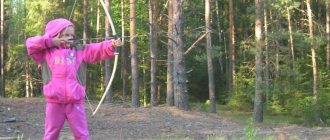Oksana Nikolaevna Polezhaeva
Card index of didactic games on ecology for children of senior preschool age
Card No. 1
“What do we take in the basket?”
.
Didactic task : to consolidate in children the knowledge of what crops are harvested in the field, in the garden, in the vegetable garden, in the forest.
Learn to distinguish fruits based on where they are grown.
To form an idea of the role of people in conservation of nature.
Materials: Pictures of vegetables, fruits, cereals, melons, mushrooms, berries, as well as baskets.
Progress of the game. Some children have pictures depicting various gifts of nature. Others have pictures in the form of baskets .
Children - fruits disperse around the room to cheerful music, with movements and facial expressions they depict a clumsy watermelon, tender strawberries, a mushroom hiding in the grass, etc.
Children - baskets must collect fruits in both hands. Necessary condition: each child must bring fruits that grow in one place (vegetables from the garden, etc.)
. The one who fulfills this condition wins.
Card No. 2
"Tops - roots"
.
Didactic task: teach children to make a whole from parts.
Materials: two hoops, pictures of vegetables .
Progress of the game. Option 1. Take two hoops: red, blue. Place them so that the hoops intersect. In the red hoop you need to put vegetables whose roots are used for food, and in the blue hoop you need to put those whose tops are used.
The child comes to the table, chooses a vegetable, shows it to the children and puts it in the right circle, explaining why he put the vegetable there. (in the area where the hoops intersect there should be vegetables whose tops and roots are used: onions, parsley, etc.
Option 2. On the table are the tops and roots of plants - vegetables. Children are divided into two groups: tops and roots. Children of the first group take the tops, the second - the roots. At the signal, everyone runs in all directions. To the signal “One, two, three – find your match!”
, you need to find your match.
Card#3
Ball game "Air, earth, water"
.
Didactic task: to consolidate children’s knowledge about natural objects . Develop auditory attention, thinking, and intelligence.
Materials: ball.
Game progress: Option No. 1. The teacher throws the ball to the child and names an object of nature, for example, “magpie”
.
The child must answer “air”
and throw the ball back.
To the word “dolphin”
the child responds
“water”
, to the word
“wolf”
-
“earth”,
etc.
Option No. 2. The teacher calls the word “air”
The child who catches the ball must name the bird.
For the word “earth”
- an animal that lives on earth;
to the word “water”
- the inhabitant of rivers, seas, lakes and oceans.
Card No. 4
"Guess what's in the bag?"
.
Didactic task: teach children to describe objects perceived by touch and guess them by their characteristic features.
Materials: vegetables and fruits of characteristic shapes and varying densities: onions, beets, tomatoes, plums, apples, pears, etc.
How to play: you know the game “Wonderful Bag”
, we will play differently today. Whoever I offer to take an object out of the bag will not immediately pull it out, but after feeling it, he will first name its characteristic features.
Card No. 5
"Nature and Man"
Didactic task: to consolidate and systematize children’s knowledge about what is created by man and what nature gives to man.
Materials: ball.
Progress of the game: the teacher conducts a conversation with the children, during which he clarifies their knowledge that the objects around us are either made by human hands or exist in nature, and people use them; for example, forests, coal, oil, gas exist in nature, but houses and factories are created by humans.
"What is made by man"
? asks the teacher and throws the ball.
"What is created by nature"
? asks the teacher and throws the ball.
Children catch the ball and answer the question. Those who cannot remember miss their turn.
Card#6
"Choose what you need"
.
Didactic task: to consolidate knowledge about nature. Develop thinking and cognitive activity.
Materials: subject pictures .
Progress of the game: object pictures . The teacher names some property or sign, and the children must choose as many objects as possible that have this property.
For example: "green"
- these can be
pictures of a leaf , cucumber, grasshopper cabbage. Or: “wet”
- water, dew, cloud, fog, frost, etc.
Card#7
“Where are the snowflakes?”
Didactic task: to consolidate knowledge about the various states of water. Develop memory and cognitive activity.
Materials: cards depicting different states of water: waterfall, river, puddle, ice, snowfall, cloud, rain, steam, snowflake, etc.
Using environmental board games in environmental education
USING ENVIRONMENTAL BOARD GAMES
IN ENVIRONMENTAL EDUCATION FOR SUSTAINABLE DEVELOPMENT GOALS
L.G. Koshkareva,
Art. methodologist of the State Autonomous Institution of Educational Institution "Center for the Development of Additional Education for Children"
Printed board games have become a fashionable hobby for young people, but among the huge number of games with different themes and strategies, environmental games are a rarity. In Russia, priority in the development of gaming educational, methodological, simulation and business environmental games belongs to Dmitry Nikolaevich Kavtaradze, Doctor of Biological Sciences, professor, head of the laboratory of management modeling at Moscow State University (1, 2). Thus, teachers of additional education actively use the set of educational simulation games “Green Backpack” (teaching decision-making in the field of environmental protection), which includes 18 games and educational materials: “Ecological balancer”, “Ecological constructor”, “Island”, “ Development without destruction”, “Boxed games”, etc. A popular publication recently has become the board business ecological game “Ecologic”, authors - Marat Sabirov and Alexey Kolmakov - published in the publication “Green Book” in September 2013 (https://zelenayakniga. ru/ru/ecologic). The Baikal Nature Reserve also released the board game “Trail near Baikal. Journey to the Bear's Corner", 2015 (3). The game is a journey, colorful, with adventures, especially popular with elementary school students.
Considering the use of environmental board games in the environmental educational process to be a productive direction, we also began to develop them. In two years, two ecological board games “Life without waste”, (2014) and “Journey around Baikal”, (2015) were developed; a little earlier, a game manual for teachers “Eco-footprint of a product”, 2012 (2014 - 2nd edition) was published. .
The first experience in the development of game teaching materials was the game manual for teachers “Eco-footprint of a product” (4). This manual, developed on the basis of the ideas of the English manual, has no analogues in Russia. The set of the game guide “Eco-footprint of goods” includes about 600 cards, a brochure, and a CD with additional materials. During the lessons, the concepts underlying the concept of sustainable development are revealed. This includes the ecological footprint, alternative energy, product life cycle, circular economy and much more.
Using the example of one small but very popular product - a chocolate egg - its life cycle from “cradle to grave” is explored. After the participants independently lay out cards showing the stages of extraction of raw materials, production of individual components, and their transportation, they have a visual representation of the “ecological load” of a chocolate egg. In the subsequent conversation, accompanied by a colorful presentation, class participants, together with the teacher, clarify certain aspects of the production and transportation of this product, and then think about ways to reduce the “ecological footprint” of the product.
Teachers of the Tulun branch of the Fraternal Pedagogical College. Photo by A. Pulyaev.
More than 20 seminars, classes and master classes were held based on the game manual, through which more than 600 people were trained. These were teachers, educators, additional education teachers, representatives of the administration of educational institutions - directors, deputy directors, heads of kindergartens. In addition to them, representatives of public and commercial organizations, as well as middle and high school students, were trained. Geographical coverage went beyond the Irkutsk region - Irkutsk, Angarsk, Cheremkhovo, Baikalsk, Tulun, Chita, Usolsky, Cheremkhovo, Irkutsk and Tulunsky districts - and covered such municipalities as Altai, Buryatia, Krasnoyarsk, Kemerovo, Moscow, St. Petersburg, Petrozavodsk , Kaliningrad, Kazan, Transbaikalia, Khakassia, Bryansk, Yekaterinburg, Nizhny Novgorod. Vladivostok, Murmansk, Arkhangelsk region, the benefit also reached the republics of Belarus, Ukraine, and Moldova.
In addition to seminars, the presentation of the “Ecological Footprint of a Product” manual took place at regional and international conferences on education for sustainable development in Irkutsk, Moscow, St. Petersburg, and Ustyansky district. The seminars and meetings held showed that the game guide “Eco-footprint of a product” turned out to be relevant and in demand in the light of the approved federal state educational standards for the formation of an environmental culture and a new type of thinking in accordance with the modern concept of sustainable development.
According to participants' feedback, the manual has a strong influence on environmental consciousness and allows for the practical formation of environmental thinking. It can be used in extracurricular, educational and research, project, game, club and leisure activities, in summer and winter camps. The use of the manual in the educational and educational process allows you to increase motivation to change behavior to environmentally friendly ones, develops interest in studying the relationship between man and nature, forms additional knowledge in ecology, geography, chemistry, natural science, and helps the development of interdisciplinary knowledge. Working in a group contributes to the development of skills to work in a team, organize cooperation, reason, generalize, and classify. And, as the teachers suggested, the game guide gives an idea of the many professions that can be discussed when laying out the production chains of a chocolate egg.
WITH
The next environmental board game is “Life Without Waste”. The idea to develop the game appeared after visiting the exhibition “Necessary from Unnecessary” in the city of Cheremkhovo, which presented magnificent works from different types of waste: plastic bottles, jars, disks, clothes, broken watches, shoes, disposable tableware, etc. All this creative diversity begged the question: “How much waste can be recycled in this way?” A few more questions for teachers and children, after which the need to develop accessible information materials on the topic of waste becomes clear. But in what form should the information be presented so that a topic that is unattractive at first glance becomes interesting and useful in everyday life? The idea came to develop an educational game with simple game mechanics and questions on the topic of waste. Since I definitely wanted to formulate questions on the modern concept of “Zero Waste”, the name of the game came naturally - “Life without waste”! It contains 100 questions and answers, divided into five types of cards: Household Waste, Hazardous Waste, Waste Management, Eco-Label and Situation. Players, moving around the playing field, must collect as many eco-bonuses as possible by correctly answering the questions on the cards. Players consider the questions from the “hazardous waste” and “eco-labeling” categories to be the most difficult. The game is designed for participants 12 years of age and older, but practice has shown that younger children can also play it. The game can be played by 2 to 4 players or teams. The game is suitable for family games, for spending leisure time in summer camps and, of course, for use in the educational process. The game sold out mainly in the Irkutsk region and Buryatia; there were requests from Moscow, St. Petersburg, Vladivostok, Khakassia, and Krasnoyarsk.
AND
, finally, the regional board game “Journey around Baikal. An educational game for everyone,” (2015) appeared in response to requests from participants in the educational process, since textbooks on “Baikal Studies” for grades 5, 6, 7 are being tested in the region (authors E.N. Kuzevanova and V.N. Sergeeva ).
The main advantage of the game is that the questions and answers in the game are given in accordance with the latest scientific data. In doubtful cases, repeated consultations with scientists were carried out. The famous scientist, Doctor of Biological Sciences, Professor Vadim Viktorovich Takhteev, took on the work of the scientific editor. Therefore, you can safely use the data provided on the game cards in education and enlightenment.
AND
The game offers 100 questions about Lake Baikal of varying difficulty. They are distributed in the game into three levels. Level 1 – “Acquaintance with the endemics of Baikal”, players are offered photographs of 20 endemics of the lake and a description of their way of life. Photos of the famous Baikal animal photographer Sergei Didorenko were used. Level 2 – “Curious traveler” – 30 cards with more or less simple questions about Lake Baikal. 3rd - the most difficult level - “Erudic - traveler” - there are 50 questions, sometimes unexpected, and detailed answers. There are three types of winners in the game: “Connoisseur of Baikal”, “Defender of Baikal” and “Fast Tourist”. In addition to the educational part, the game has great potential for developing environmental thinking and behavior. Photo pictures in the form of circles are offered - examples of the negative impact of tourism on the nature of Lake Baikal; players need to answer three questions: what caused the phenomenon, what will happen if nothing is done and what needs to be done to solve this problem?
The children rate the games offered very highly; they like the unusualness, originality, environmental friendliness, teamwork, and educational content. But most of all I liked the emotional assessment of one of the participants: “It was great to play - better than at a disco!” Experts also highly appreciate games and manuals, emphasizing their significant developmental and educational potential, the ability to form an ecological worldview, an individual, personal attitude to environmental problems, which in turn contributes to the formation of the fundamental components of environmental culture.
1. Imitation models and games of the 18th-21st centuries. Reader on interactive teaching methods [Electronic resource] / D. Kavtaradze, E. Leigh, E. Likhacheva and others - Moscow, 2014. - P. 395.
2. Kavtaradze D. Education and play: an introduction to interactive teaching methods. - Education M, 2009. - P. 176.
3. “The trail near Baikal. Journey into the bear's corner." Belozerova O., Buntovskaya S.N. et al., Baikal Nature Reserve, 2015.
4. “Ecological footprint of a product,” compiled by: L.G. Koshkareva; editor: Yu.G. Zhilina; design and layout: T.V. Vysotskaya. – 2nd ed., revised. – Irkutsk: ed. IRO "Baikal Ecological Wave", 2014.
Ecological games in the preparatory group: card index with goals
Educators can either come up with activities on their own or take ready-made options from teaching aids and other sources. On the topic of environmental studies, the preparatory group has an extensive card index of didactic games on ecology.
Guessing vegetables with your eyes closed
"Guess"
Goal: to teach the child to tactilely distinguish objects.
Didactic games for middle school children
Procedure: the teacher uses toy fruits and vegetables for classes. Maybe real ones. The kids stand in a circle and, one by one, are given dummies. Eyes must be closed. The child must guess what is in his hands. If necessary, you can add clues, for example, “his color is red.”
“Who eats what?”
Goal: to develop the child’s knowledge about nature, to teach him to distinguish predators from herbivores.
Procedure: the guys are divided into groups. Each person receives two types of cards depicting animals and their food. Kids should fold the cards in such a way that it is clear who eats what. As a competitive element, one of the conditions can be declared speed of execution.
"Seasons"
Goal: to form an idea of the phenomena that accompany different seasons.
Procedure: the teacher names different phenomena, and the children must guess which seasons it refers to.
Examples of questions:
- melting snow (spring);
- snow falls and falls (winter);
- leaves turn yellow (autumn);
- people swim in the river (summer).
"Who moves how"
Goal: gaining knowledge about the animal world.
Procedure: the teacher names an animal for each child.
For your information! Children must reproduce how this or that animal moves.
"Properties of Living"
Goal: to teach children to distinguish different properties and find objects based on a single characteristic, parallels in different objects, and also tell them that different objects can have the same characteristics and properties.
Progress: the main props are cards. They can contain any environmental elements. The teacher gives the task to find objects with the same properties or colors. For example, when asked for “vegetable,” children must select all of the vegetable cards. When you request “red”, select all the cards that contain elements of the desired shade.
Fizminutka
Goal: combine intellectual development with physical development. This is a great interpretation of a warm-up. The exercise teaches you to evaluate actions related to nature.
Progress: preschoolers should get up if the action causes harm to the world around them, and sit down if it does the opposite.
Examples of questions:
- a man breaks branches;
- a girl whitewashes a birch tree;
- a boy waters a tree;
- people left garbage on the river bank;
- The guys are treating a sick chick.
Advice from Dr. Komarovsky: teaching a child to dress independently
"Guess it"
Purpose of the game: to teach children to solve subject riddles, study the animal world, and develop attentiveness.
Progress of the game: the presenter expressively reads the riddle. The children's task is to find the correct answer among the pictures on the table.
At the end of the game, think of a controversial action and ask the guys to express their opinions. At the end, be sure to explain which option is correct.
"Guess what I'm talking about"
Purpose of the game: development of thinking, ability to analyze and isolate information.
Progress of the game: the teacher voices the qualities of an object. You need to select so many properties so that it is clear what we are talking about. There are dummies or pictures on the table. Children must find among them the object that the teacher spoke about.



